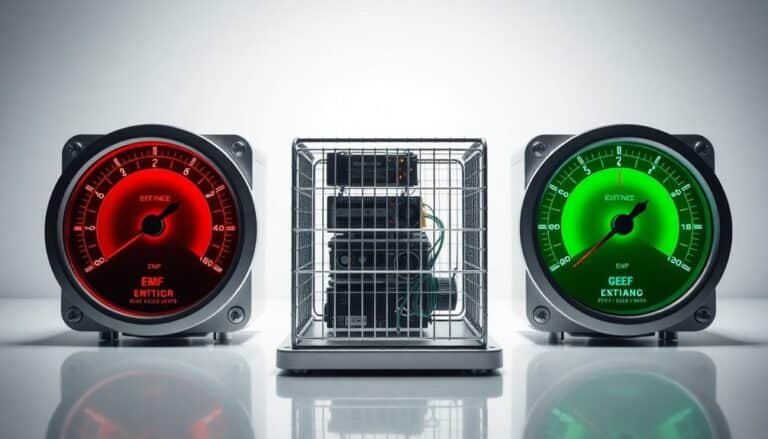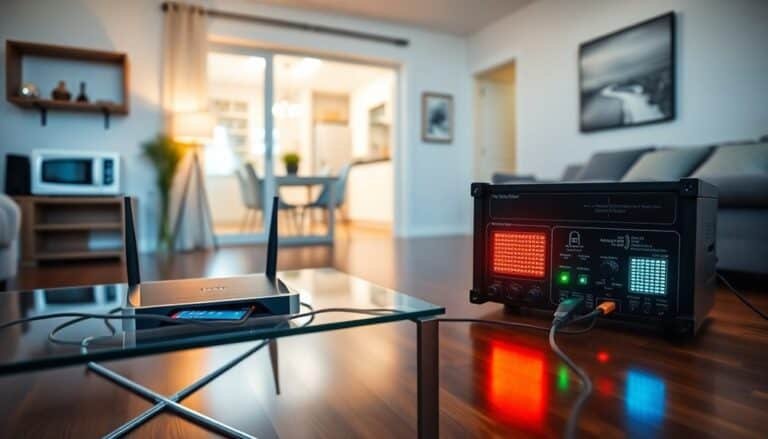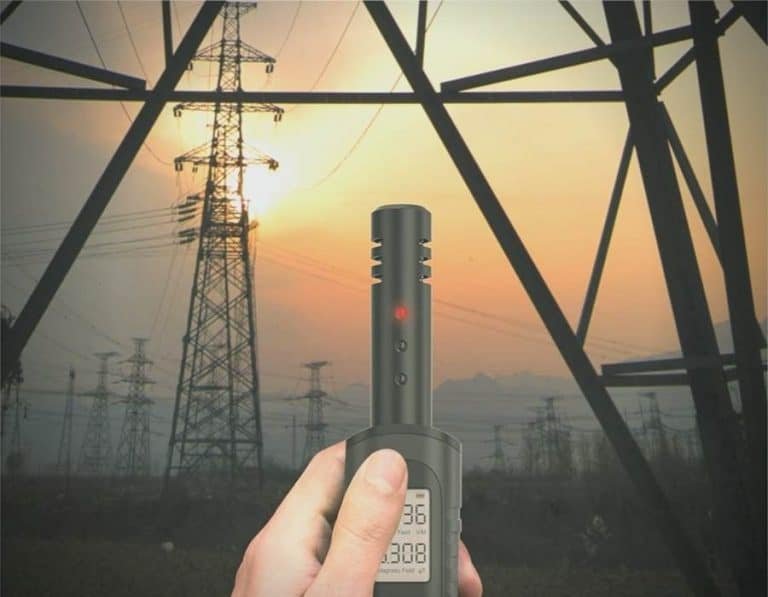Conducting a Home EMF Survey (Step by Step)
Begin a home EMF survey by defining objectives and creating a room floor plan, then gather equipment like EMF meters and a body voltage test kit. Conduct measurements during peak usage, documenting readings, and analyze EMF sources to identify areas needing exposure reduction.
Based on your findings, take actions to mitigate EMF exposure and regularly monitor for changes to assess potential risks. Further steps can refine mitigation strategies for effective risk management.
Disclaimer: As an affiliate, I may collect a share of sales from the links on this page.
Define Your Objectives
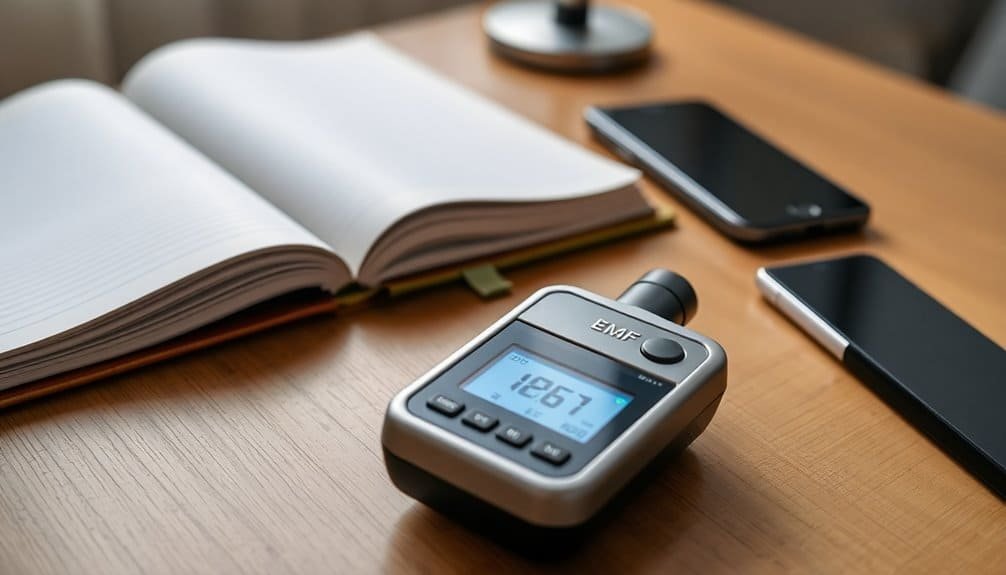
Defining your objectives for an EMF survey is essential for effective management. Start by focusing on reducing exposure to harmful EMF levels. Identify sources generating high EMF, like power lines or devices. Assess how these levels impact health and safety, then review current measurements against established safety standards. It is important to conduct regular EMF radiation surveys to monitor any changes in exposure levels over time. Additionally, understanding health effects linked to EMF exposure can guide your mitigation strategies.
Develop strategies for mitigation, including methods to shield areas where people spend significant time, like bedrooms and living spaces. Create a plan for ongoing EMF management, ensuring you can adapt based on future assessments. Prioritize high-risk spaces to maximize your survey’s effectiveness in safeguarding health and well-being.
Gather the Necessary Equipment
To conduct a thorough EMF survey, you need the right equipment to measure electromagnetic fields accurately. Start with an EMF meter; options include the Trifield Meter, which measures magnetic, electric, and radio frequency fields. The RF EMF Strength Meter is great for high-frequency sources like Wi-Fi. For body voltage assessment, consider a Body Voltage Test Kit. An AM Radio can help detect RF fields while Stetzerizer Filters can mitigate interference. Additionally, you can purchase various EMF meters such as the MF100 or EMF20 models, which offer specific measurement capabilities. Finally, usage of distance measurement tools optimizes spacing from EMF sources, ensuring accuracy. It’s important to note that safe EMF levels are critical for maintaining health and minimizing exposure. If budget is a concern, basic kits from EMFCheck offer essential tools for effective surveys.
Create a Floor Plan Map
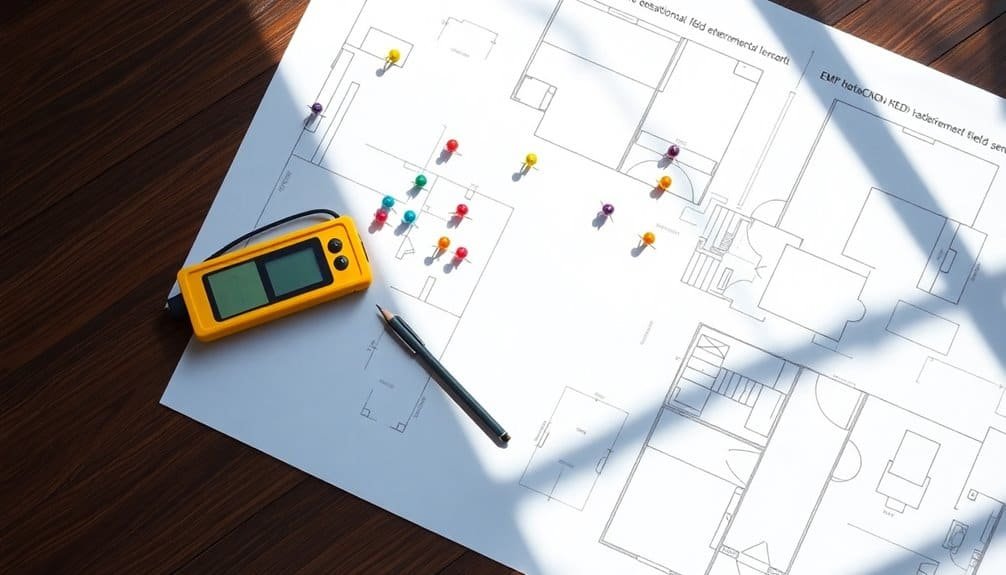
Creating a detailed floor plan map is essential for an effective EMF survey. Start by ensuring your property’s floor plan is accurate and current. Include all rooms, closets, and utility spaces, marking doors, windows, and major electric features.
Indicate locations of EMF sources, highlighting problem areas like power lines or cell towers. Identify low-EMF zones such as bedrooms and offices, and use color coding to mark proximity to external sources. An effective assessment should include a clear checklist of EMF tests to ensure all critical areas are covered. Additionally, consider measuring radiation levels in each room to identify potential hazards.
Annotate specific measurement points, assigning codes for clarity. This map will serve as a thorough guide for your survey and future mitigation strategies, ensuring an organized approach to reducing EMF exposure.
Schedule Your Measurements
Scheduling measurements for your EMF survey is essential to capturing accurate data that reflects everyday conditions.
First, identify peak usage hours: generally from 19:00 to 21:00 for electric devices, and weekdays for mobile usage. Don’t forget to include weekend measurements to track usage variations.
Space measurements over several days, and record them consistently in an Excel sheet by date and time. Additionally, assess different times of the day—morning, afternoon, and evening—to capture fluctuations in EMF levels.
Account for environmental factors too, since weather can influence your results markedly throughout the measurement process.
Set Up the Equipment Properly
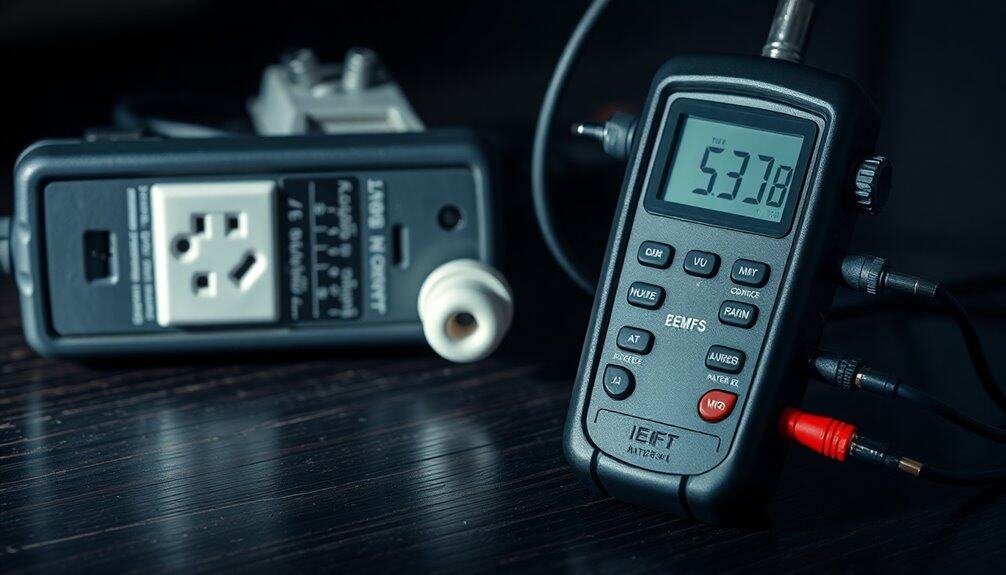
Setting up your equipment correctly is essential for obtaining accurate EMF measurements.
First, choose the right EMF meter to measure the types of EMFs you’re investigating—RF, ELF magnetic, and ELF electric fields.
Next, understand your meter’s settings, including measurement ranges and modes. Read the user manual and watch demonstration videos for guidance.
If your meter needs calibration, check that it’s done properly.
Finally, verify that the meter has sufficient battery power for the entire survey.
Each of these steps guarantees your readings will be reliable, giving you the information you need to assess your home’s EMF levels effectively.
Conduct Your EMF Survey
To effectively conduct your EMF survey, start by utilizing the appropriate meters for each type of field. Use:
- ELF meters for magnetic and electric fields from appliances and power lines.
- RF meters to measure radiation from wireless devices.
- Dirty Electricity meters to assess pollution from lighting and tech.
Focus on areas where people spend the most time, like bedrooms and living areas.
Familiarize yourself with the units of measurement, such as V/m or A/m. Remember to take multiple measurements throughout the day to capture variations.
Log your readings for later analysis, helping you track exposure trends over time.
Identify EMF Sources
Identifying EMF sources in your home is a pivotal part of understanding your exposure. Start by evaluating electronics like cell phones, laptops, and tablets, which emit EMF while in use.
Next, consider home appliances, such as microwaves and televisions, which produce significant EMF during operation.
Don’t overlook power lines and household wiring; they can contribute to background levels.
Wi-Fi routers and smart devices continuously emit EMF to maintain connections.
Finally, assess smart meters, which track energy use—often emitting low-level radiation.
Recognizing these sources helps you make informed decisions about managing your EMF exposure effectively.
Analyze Your Readings
When analyzing EMF survey readings, how do you guarantee your results provide accurate insights?
Start by understanding the types of EMF you’re measuring, like:
- Radiofrequency (RF) emissions, measured in microwatts per square meter (( mu W/m^2 )).
- Electric fields, measured in volts per meter (V/m).
- Magnetic fields, measured in milliGauss (mG) or microTesla ((mu T)).
Next, make sure you establish baseline levels against known safe limits.
Identify peak exposures that indicate potential health risks, and correlate your readings with the proximity of EMF sources.
Finally, factor in the time of day and spatial distribution for thorough analysis.
Take Action on Findings
Taking action on your EMF survey findings is essential for managing exposure risks.
First, implement shielding solutions, like applying EMF shielding paint or using stainless steel mesh on walls.
Increase distance from EMF sources by positioning furniture away from electronics and moving from high-EMF areas when possible.
Turn off unused devices to reduce overall exposure and select low-EMF appliances during upgrades.
For added protection, install shielding fabrics or curtains on windows facing potential radiation sources.
If needed, consider engaging professionals for optimizing wiring and installing more effective shielding solutions, ensuring a safer environment for you and your family.
Maintain Regular Monitoring
To effectively manage EMF exposure, maintaining a regular monitoring schedule is essential. This allows you to stay informed about changing levels in your environment.
Consider the following factors:
- Frequency of Checks: Monitor EMF levels regularly, especially in areas with new sources of emissions.
- Time of Day: Schedule monitoring at different times, as usage patterns can cause fluctuations.
- Environmental Factors: Assess how weather and nearby EMF sources influence your readings.
Frequently Asked Questions
How Often Should I Conduct a Home EMF Survey?
You should conduct a home EMF survey whenever new sources emerge, like power lines or cell towers, after renovations, when upgrading technology, or regularly to monitor changes and guarantee safety over time.
Can I Use a Smartphone App for EMF Measurements?
Sure, if you fancy ghost-hunting with your smartphone! Those EMF apps are like a fortune cookie—fun, but don’t count on them for serious measurements. You’ll need real equipment for accurate assessments.
What Safety Precautions Should I Take During the Survey?
During the survey, you should maintain distance from EMF sources, turn off unnecessary devices, use shielding materials if needed, and follow health guidelines to minimize exposure. Limit your time in high EMF areas too.
Are There Specific EMF Exposure Limits I Should Know About?
Did you know the average indoor EMF exposure in Europe is below 100 microwatts/m²? You should know exposure limits vary by country, with BioInitiative recommending safety limits between 3-6 microwatts/m² for indoor environments.
How Can I Visually Represent My Survey Findings?
To visually represent your survey findings, use heat maps, 3D field isosurfaces, or contour plots. These methods clearly illustrate field strength and distributions, making complex data easier for you and your audience to understand.
Conclusion
Conducting a home EMF survey is crucial for understanding electromagnetic fields in your environment. Identifying sources and analyzing readings ensures a safer living space. Regular monitoring enhances awareness and allows for proactive measures. Knowledge empowers you to improve your home’s safety and comfort. Stay vigilant and let data guide your decisions for a healthier environment.

